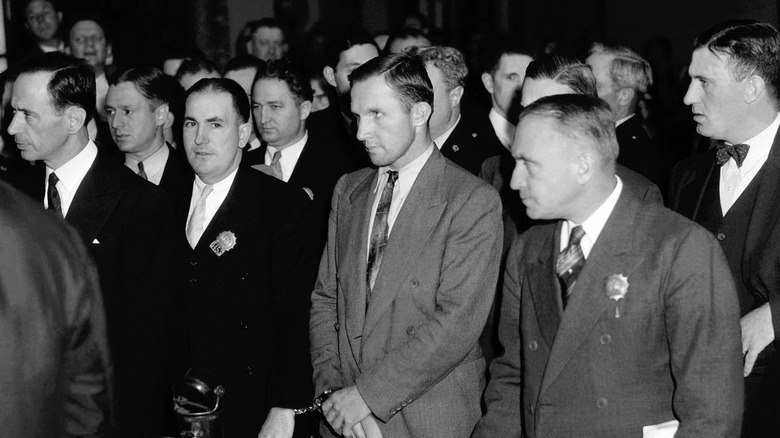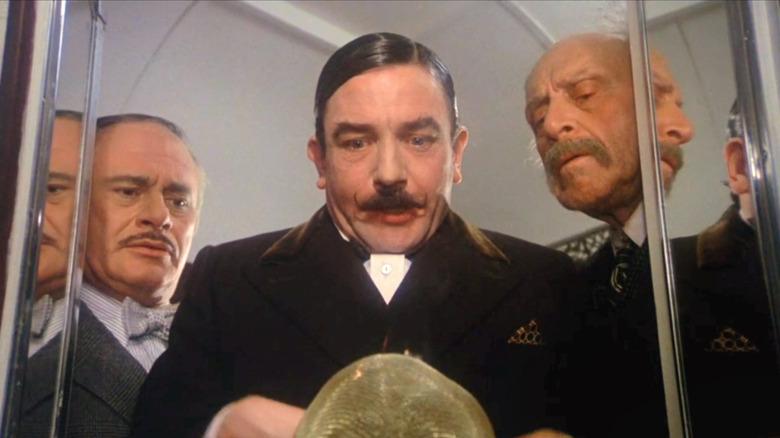The Terrifying True Story That Inspired Agatha Christie's Murder On The Orient Express
Dame Agatha Christie sure knew how to spin a good yarn, and her prolific ability to write page-turning whodunnits helped her become the best-selling novelist of all time. Nowadays, she is regarded as the mother of the cozy murder mystery and she dominated the light-hearted crime genre in the mid-20th century with the help of her two most famous sleuths, Hercule Poirot and Miss Marple. We're all familiar with the set-up: picturesque locations, amiable amateur detectives, upper-crust suspects who all have a motive, and a satisfying final reveal. Yet while Christie's fiction was usually a non-threatening comfort read, she wasn't above dipping into more grisly real-life crime for inspiration. Indeed, she ripped elements of the "biggest story since the Resurrection" straight from the front pages for one of her most popular novels.
Published 14 years after Christie first introduced Hercule Poirot in "The Mysterious Affair at Styles" (1920), "Murder on the Orient Express" saw the author really expanding her scope. She'd done a mystery on a locomotive before with "The Mystery of the Blue Train" but this was something far more lavish, set onboard the most luxurious mode of transport on the European continent. With a large cast of international suspects on hand to bump up the intrigue, it would become arguably the most famous whodunnit ever written.
Monsieur Poirot is heading back to London from from Istanbul on the titular train when he is approached by American racketeer-turned-businessman Samuel Ratchett. Ratchett has been receiving death threats and wants to hire the detective for protection, but Poirot finds him repellent and turns the offer down flat. The rejection proves fatal, as the train gets stuck in a snowdrift crossing Serbia and Ratchett is found stabbed to death in his berth.
Poirot swings into action and finds a series of conflicting clues including a piece of paper bearing the name "Daisy Armstrong," a young girl whom Ratchett killed during his bad old days as a gangster. Furthermore, Poirot discovers that 12 of his fellow passengers all have a connection to the slain toddler. It's fairly standard Christie stuff, but the conclusion is one of the most audacious twists in Dame Agatha's entire canon and it is an unusually dark story involving kidnapping, child murder, suicide, and broken lives. Which is fitting, because the tragic backstory of Daisy Armstrong mirrored the terrifying Lindbergh kidnapping case that rocked the world two years earlier.
The shocking kidnapping of Charles Lindbergh Jr.
Five years after he achieved global fame for becoming the first solo aviator to fly non-stop across the Atlantic, Colonel Charles Lindbergh found himself in the headlines again under far more shocking circumstances. On the night of March 1st 1932, his 20-month-old son Charles Augusts Lindbergh Jr. was abducted from his crib at the family's rambling estate in New Jersey. The toddler's nurse, Betty Gow, noticed Charles Jr. was missing and a ransom note demanding $50,000 was discovered. Despite the kidnapper's dire warning, police were summoned and a search of the premises revealed that the culprit had gained access through the nursery window via a ladder.
The news quickly spread as hundreds of police officers were involved in a search for the missing child. Lindbergh Sr. and his wife Anne asked friends to reach out in the hope of contacting the kidnappers, while the investigation was hampered by a slew of false confessions. Even the criminal underworld got involved in trying to crack the case, with imprisoned mobster Al Caponeposting a substantial reward and promising to pull a few strings if he was given bail. The authorities declined his offer.
Five days after the abduction, the Colonel received a second note increasing the ransom figure to $70,000. A further series of notes over the coming days included instructions for the hand-off. Lindberg indicated his willingness to pay and the kidnappers sent the child's sleep clothes as a proof of identity. Negotiations continued and a payment of $50,000 was given to a man identifying himself as "John" in exchange for yet another note revealing the baby's whereabouts.
Sadly, the information was false and Charles Lindbergh Jr. was found dead on May 12th. Gruesome evidence suggested that the child was murdered not long after the kidnapping and his body was badly decomposed. J. Edgar Hoover threw the full weight of the FBI behind a nationwide investigation and the case claimed another victim on June 10th. Violet Sharpe, who worked for Anne Lindbergh's mother, took her own life when she came under suspicion.
Over two years after the kidnapping, a German migrant named Bruno Richard Hauptmann was apprehended and indicted for extortion and murder. On February 13th 1935, he was found guilty of murder in the first degree and sentenced to death. The following year, Hauptmann died in the electric chair.
Similarities between the Lindbergh kidnapping and Murder on the Orient Express
The Lindbergh kidnapping case made news around the world, presumably drawing gasps from Agatha Christie and she followed the story over her tea and crumpets in England. It also gave her the idea for the tragic backstory that motivates the events of "Murder on the Orient Express," first published in January 1934 while the investigation was ongoing. In the novel, a 20-month-old boy was switched out for a 3-year-old girl, but many of the key details remained the same. Daisy was also the child of a famous family, snatched from her bed and found dead after the ransom was paid. Much like the real case, a family employee died by suicide after they were accused of the crime, and Christie added two further tragic incidents to the sorrowful tale. Unlike Mr. and Mrs. Lindbergh, Daisy's mother miscarried her second baby when it was revealed her first child was murdered, and her father was so grief-stricken that he shot himself.
Suspects in Agatha Christie novels usually have a wide variety of motives, but the painful connection between the passengers on the Orient Express and Daisy Armstrong gives the novel a far more somber tone. It also provides a tough moral choice for Hercule Poirot and his little gray cells when (spoiler alert) he reaches an unlikely but unavoidable conclusion: They all did it. There is little doubt that Ratchett is a vile excuse for a human being and he had it coming, but to what extent can he sympathize with the murderers?
His eventual decision lingers long after the book is closed and the novel poses a troubling question: Are there circumstances when vigilante justice becomes forgivable? It's grim stuff and we might question how tasteful it was for Christie to use such a harrowing case as the basis for a best-seller, but her inspiration wasn't purely the Lindbergh kidnapping. Traveling on the Orient Express was a lifelong dream for the author and she finally got her chance in 1931. Elements of her journey, including the train getting dramatically stuck in snow, also found their way into the novel. "Murder on the Orient Express" has since sold millions of copies and provided the source material for two of the best Agatha Christie movies, most notably Sidney Lumet's 1974 version with Albert Finney in Oscar-nominated form as Hercule Poirot.


